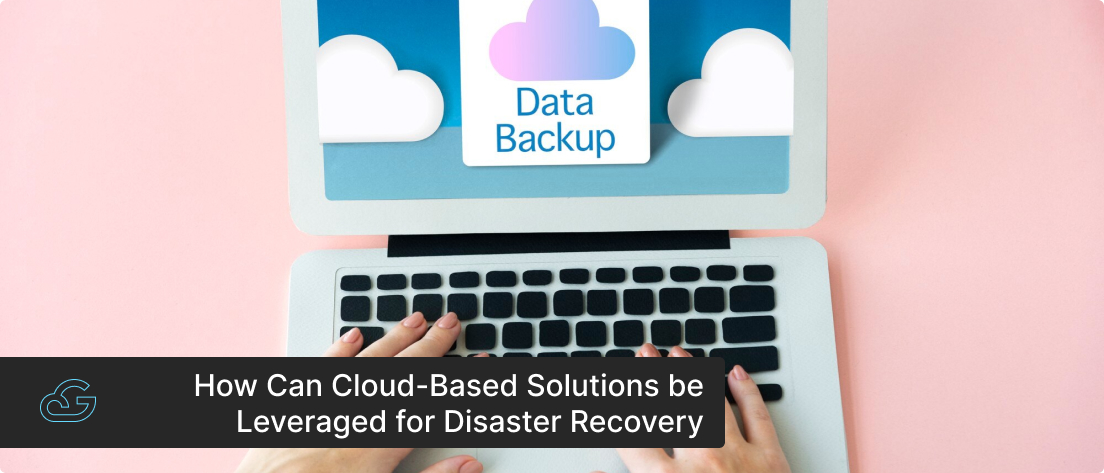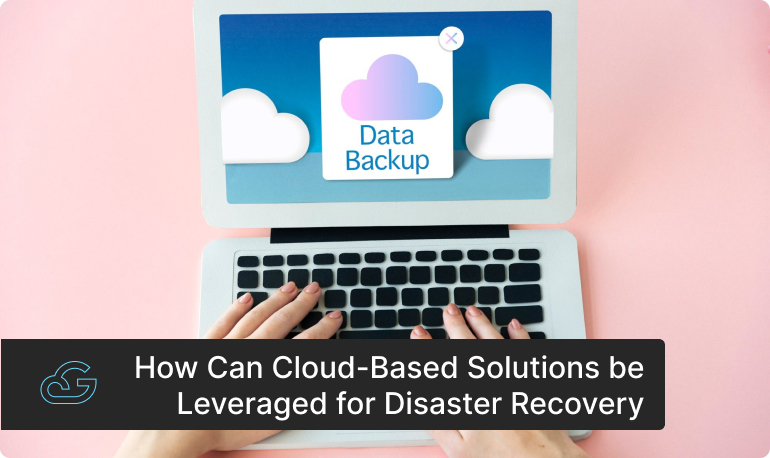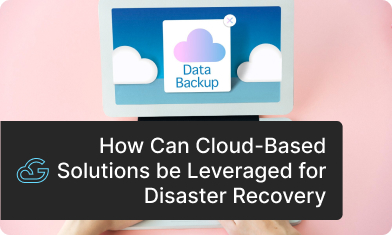Blogs / Cloud Managed Services
How Can Cloud-Based Solutions be Leveraged for Disaster Recovery
By
Sibin Vincent
Posted: March 25, 2024
• 6 minutes and 26 seconds
Downtime and disruptions can be devastating for any business, whether from hardware failures, cyberattacks, or natural disasters. Disasters of this kind pose a significant threat to an organization's continuity and financial well-being. They can bring your business to a screeching halt and jeopardize everything from customer data to your hard-earned reputation. You can't predict when or how they'll strike, but you can be prepared. Fortunately, Cloud Disaster Recovery (DR) offers a quick bounce-back solution.
Challenges of Traditional Disaster Recovery Solutions
- Limitations of Geographically Fixed Infrastructure: Traditional DR methods are often constrained by the physical locations of backup sites, which can limit widespread disaster recovery coverage.
- High Setup and Maintenance Costs: Establishing and maintaining physically separate backup locations can incur significant upfront and ongoing expenses, including hardware, infrastructure, and maintenance costs.
- Minimal Protection in Widespread Events: Geographically fixed backup locations offer limited protection in scenarios where widespread events, such as natural disasters or large-scale cyberattacks, disrupt both the primary and secondary sites simultaneously.
- Slow Data and System Recovery: The process of recovering data and systems from backups in traditional DR setups can be slow, resulting in prolonged downtime for critical operations during a disaster event.
What is Cloud-based Disaster Recovery?
Cloud-based Disaster Recovery (DR) is a set of strategies and tools that let you quickly restore IT infrastructure, applications, and data after a disaster to minimize downtime, data loss, and operational troubles.
For instance, let’s assume that you are an e-commerce business owner. A cloud DR plan can replicate your website, databases, and order processing systems across multiple geographically dispersed cloud data centers. In the event of a server failure or cyberattack, automated failover mechanisms kick in, easily redirecting traffic to redundant cloud instances to ensure uninterrupted customer access and transactions. This helps you protect your revenue streams and promotes customer trust and loyalty by providing a flawless online shopping experience even during unexpected disruptions.
Have you ever considered the impact Disaster Recovery could have on the day-to-day operations of your business? Is investing in Disaster Recovery worthwhile?
This blog talks about different cloud-based disaster recovery solutions, their advantages over traditional DR methods, and their significance for your business.
Why is Cloud Disaster Recovery Important?
Cloud-based Disaster Recovery leverages cloud computing solutions for a more modern approach. Instead of relying on separate physical backups, you can store your data and even run your critical systems directly in the cloud. Cloud service providers have data centers all over the world, so even if something happens to your main location, your data and systems are safe and sound elsewhere. This means you can get your business up and running again much faster, with minimal downtime.
Secure Your Business with Cloud-based Disaster Recovery Solutions
Finding the optimal disaster recovery solution for your company involves considering several factors: your existing IT infrastructure, current backup and recovery methods, and the critical assets requiring protection. Want to evaluate the best strategy fit into your business? Let's explore some of the most common technologies and techniques used to build a robust cloud-based disaster preparedness strategy.
-
Managed Disaster Recovery Service
Managed Disaster Recovery Services or Disaster Recovery as a Service (DRaaS) providers offer fully managed disaster recovery solutions in the cloud. These services typically include features such as automated failover, continuous data protection, and orchestrated recovery processes. DRaaS solutions allow you to quickly recover your IT infrastructure and applications in the cloud following a disaster with minimal downtime and data loss.
-
Virtual Machines
Virtual machines (VMs) act as software replicas of your physical servers, including everything from operating systems to data. Stored securely in the cloud, these VM backups are kept geographically separate from your primary location. In the event of a disaster, the cloud solution swiftly launches these pre-configured VMs, restoring critical applications and data in the cloud environment to minimize downtime and ensure business continuity.
-
Cloud Backup Services
Cloud backup services provide a secure off-site storage solution for your data and applications. These services use automatic backups, data encryption, and customizable retention policies to ensure your information is always protected.
-
Cloud Replication
Cloud replication creates near real-time copies of your data and applications in the cloud, ensuring you always have an up-to-date backup. If a disaster strikes, simply switch to your cloud copy and keep your operations running smoothly.
-
Backup and Recovery Software
Cloud-based backup and recovery software solutions provide you with tools to manage your backup and recovery processes in the cloud. These solutions often offer features such as data deduplication, compression, and backup scheduling to protect your data and applications. AWS Backup, Azure Backup, and Veeam Backup & Replication are some cloud-based backup and recovery software solutions you can utilize for your disaster recovery requirements.
-
Storage Services
Cloud storage offers a secure and scalable solution for all your business data needs. From everyday backups to disaster recovery images (a complete, compressed snapshot of a system's state at a specific point in time), you can store everything with ease. These services ensure data integrity and availability through features like data replication (keeping backups safe in case of issues), encryption (protecting your data from prying eyes), and versioning (allowing you to revert to earlier versions if needed).
The Disaster Recovery as a Service Market Size (DRaaS) was valued at
USD 11.5 billion and is expected to grow by USD 82.8 billion registering
a CAGR of over 22% between 2022 and 2032, due to the growing awareness
of security.
Why Should You Go with Cloud-based Disaster Recovery Solutions?
For businesses of all sizes, cloud-based disaster recovery solutions offer numerous advantages, ensuring faster and more efficient business continuity. See how these benefits align with your business needs.
-
Scale Up, Not Out with Scalability On-demand
Whenever disaster looms, cloud DR allows quick resource adjustments (CPU, memory, storage), unlike traditional approaches that require adding more machines. You can begin with a modest setup and easily adjust resource levels as your business expands.
-
Cost-Effective Data Protection with Pay-as-you-go Pricing
Forget the hefty upfront costs of physical infrastructure! Cloud DR operates on a pay-as-you-go model, eliminating the burden of maintaining servers, storage, and offsite data centers. Now, even small and medium businesses can afford comprehensive disaster recovery plans.
-
Back-Up and Be Back in Business with Faster Recovery
Every minute of downtime equals lost revenue. Traditional recovery methods can take hours or even days, amplifying the impact of disruptions. Cloud DR, however, minimizes downtime through constant data backups to the cloud. This allows for near-instantaneous data recovery, getting your business back on track quickly and minimizing operational costs associated with delays.
-
Built-In Geographic Redundancy To Support Business Operations
Localized disasters shouldn't cripple your entire operation. Cloud DR offers built-in geographic redundancy, automatically replicating your data across different regions. This ensures your critical data remains secure and accessible even if a disaster affects one area.
-
Consistent Testing for Compliance Verification
Regular testing and compliance verification are crucial for disaster recovery plans. However, these processes can be complex and resource-intensive. Cloud DR simplifies this by enabling non-disruptive, scenario-based testing without taking systems offline.
-
Efficient DR Management with Dedicated Professionals
Managing disaster recovery in-house can be a complex task requiring specialized skills. Cloud DR takes the burden off your shoulders. Cloud service providers have dedicated teams of experts who continuously monitor the system and implement best practices.
-
Top-Tier Security Measures to Protect Your Data
Cloud DR offers robust security measures, including encryption, access controls, and regular security audits. This ensures your data remains protected from unauthorized access, both during transit and at rest.
-
Error-Free DR Implementation with Automated Process
Traditional DR methods often rely on manual processes, are prone to human error, and are time-consuming. Cloud DR automates these tasks, including data replication to the cloud and even failover/failback of systems during a disaster. This automation minimizes the risk of errors and significantly reduces recovery time.
Ensure Business Continuity with Gsoft Disaster Recovery Solutions
Today, a proactive approach to disaster recovery (DR) planning is crucial for organizations of all sizes. The advancements in cloud technologies, server virtualization, and hybrid backup solutions have paved the way for real-time cloud-based DR. This makes it a particularly attractive option for organizations that previously couldn't justify the high cost of traditional DR infrastructure.
By considering Recovery Time Objectives (RTOs) and Recovery Point Objectives (RPOs), you can develop a fool-proof cloud DR plan tailored to your specific needs. How? Contact a trusted managed cloud service provider like Gsoft Cloud to get comprehensive DR solutions including:
- Disaster recovery assessment to ensure readiness for any unforeseen event.
- Customized DR plan tailored to your business needs.
- Round-the-clock support for quick restoration processes.
- Wide range of DR backup solutions backed by highly redundant data centers.
- Disaster Recovery as a Service (DRaaS) for cost-saving benefits.
- Combine cloud DR with hybrid cloud and on-premises data centers for comprehensive solutions.
Get a free consultation with our experts today to learn more about our disaster recovery services.


Get Know More About Our Services and Products
Reach to us if you have any queries on any of our products or Services.











